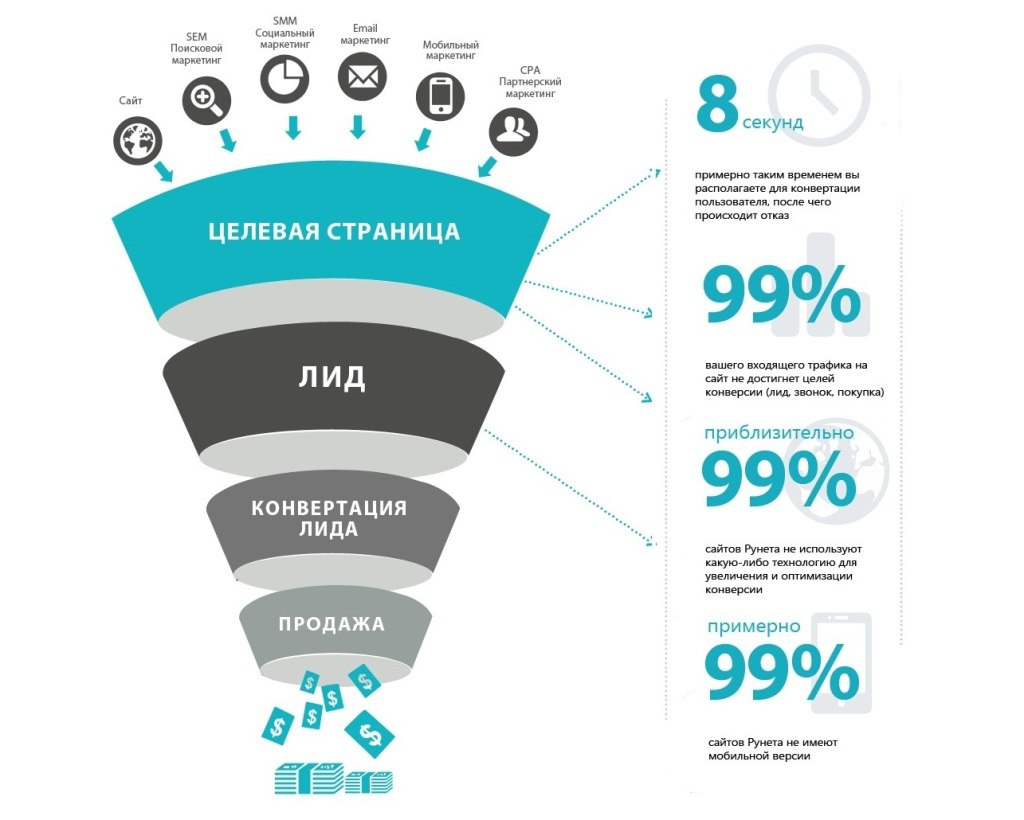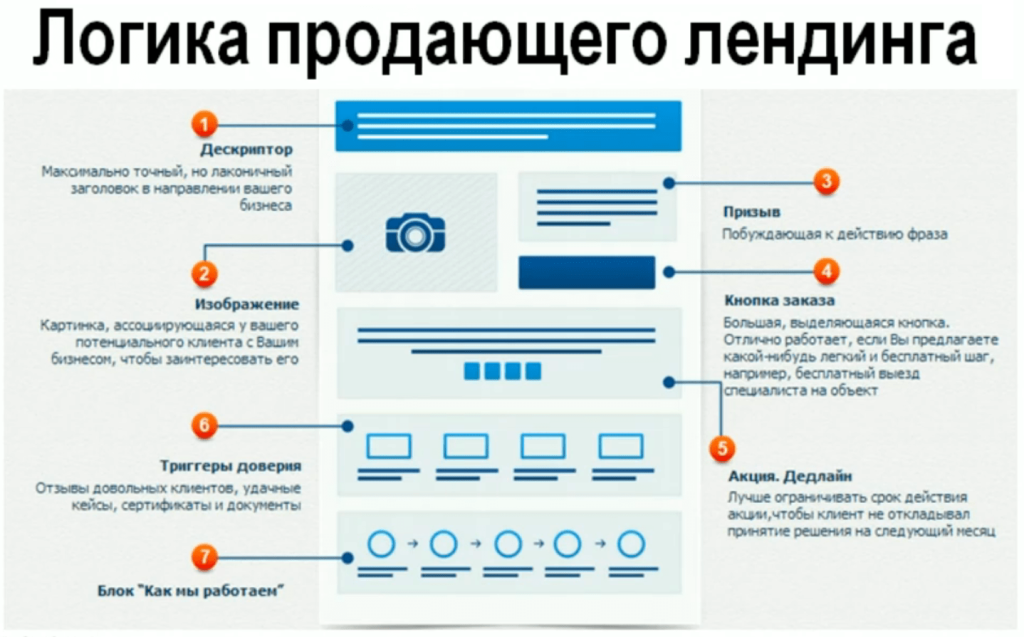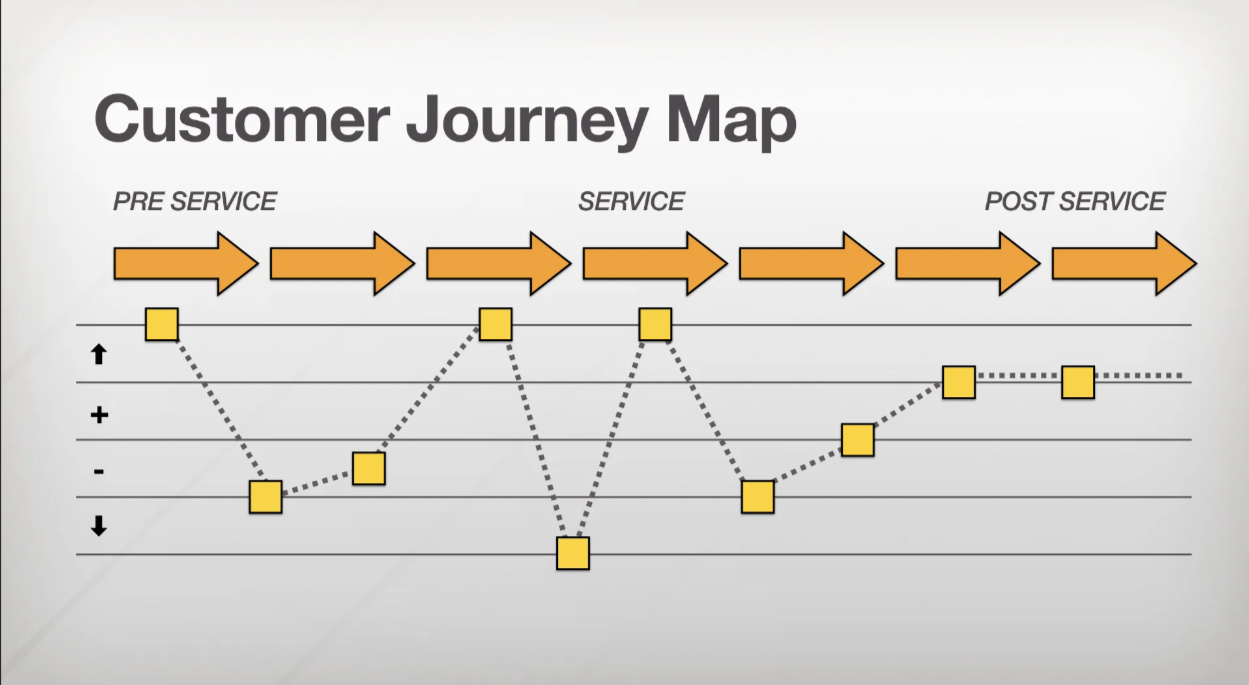How to increase the effectiveness of a landing page? This is a question that worries every marketer and business owner. Improving conversion is a key goal discussed in case studies, marketing conferences, and when launching websites, quizzes, and advertising campaigns on social networks. Conversion plays an important role in achieving success and business growth in the online environment. Let's consider several effective strategies that will help increase the conversion of your landing page.
Types of Conversion
When talking about landing page conversion, we usually mean converting visitors into leads: the number of customers who performed a target action on the landing page is divided by the total number of visitors, and then multiplied by 100% to get the conversion percentage. For example, if there were 200 visitors to the site and 30 of them left a request, then the conversion is 15%.
When a person performs the main target action on the landing page, this increases the site's macroconversion.
In addition to the main capture form, the site may also have other additional calls to action, such as subscribing to a newsletter, company news, leaving a review, or downloading a lead magnet. These micro-conversions are also taken into account when analyzing the effectiveness of the landing page.
Large marketing agencies strive not only to control the effectiveness of advertising and landing pages, but also to work with their clients' sales departments. Specialists develop scripts and analyze conversations between managers and customers to identify errors in the sales process. In this way, they increase not only conversion to leads (the number of applications from the site), but also conversion to sales (the number of deals concluded after communicating with the sales department).
It is important to understand that conversion to a lead is not as important as conversion to a sale. You can get 100 leads with an easy target action (like downloading a lead magnet), but only end up selling your service to 10 of them.
Try to focus on attracting targeted visitors to the site (those who are really interested in buying, want to calculate the cost of a service or need a surveyor to come out). There may be fewer applications, but they will be of higher quality and aimed at specific goals.

What influences conversion?
Conversion rates can vary significantly from business to business and are dependent on a variety of factors that make each case unique.
Seasonality factor:
Seasonal changes affect conversion. For example, a landing page selling air conditioners in the summer can lead to 20-30 requests per day, but after the end of the season, demand decreases.
Urgency factor:
Products and services related to food or medical needs are usually sold more frequently and quickly, as customers make decisions instantly when hungry or sick. In contrast, buying a country cottage on the seashore requires more thought.
Competition factor:
Conversion may be lower in highly competitive environments. For example, when selling offline English courses, customers look for schools nearby, and the number of potential customers is reduced due to the presence of many competitors in one area of a large city.
Upselling on the website:
The ability to make additional sales on a landing page or website, for example, offering mothers who have purchased a foreign language course for their child to enroll in a course for adults, can increase conversion.
Product cost:
- The price of a product affects conversion because a high price can create doubts in potential customers and reduce conversion.
Professionalism of the advertiser:
The effectiveness of an advertising campaign depends heavily on the skills of the advertiser. Even an imperfect landing page can be successful with well-tuned advertising, while a bad advertiser can reduce conversion, even if the landing page is well-designed.
Traffic heat:
Selling to customers who are already familiar with your company is usually easier than selling to cold customers. Therefore, using micro-conversions on the site aimed at different target audiences (for example, buy for hot ones, calculate the cost or get a personal commercial offer for warm ones, download useful material, go to a blog or subscribe to VK for cold ones) can increase conversion.

Death to Conversion
During our work in the marketing field, we have analyzed many landing pages and compiled a list of common mistakes that negatively affect conversion:
- Irrelevant offer: When a user searches for a specific service or product but lands on a page that doesn't match their search. This could be a general company catalog or the home page of a website, instead of seeing a clear offer and price for exactly what they were looking for.
- Slow loading site: If the landing page is overloaded with complex animations or videos, this can slow down the page loading speed, which leads to loss of user interest.
- Clunky Capture Forms: When a form contains too many required fields, it can discourage users and reduce their chances of converting.
- Incorrect forms of capture: If they promise to send a catalog or other information, but do not request the necessary contact information, or request information that does not correspond to the offered service, this can cause mistrust among users.
- Lack of capture forms, buttons, and calls to action: If your landing page doesn't have clear calls to action or doesn't offer the user the option to leave contact information, it limits conversion opportunities.
- Incorrect display on mobile devices: If the landing page is not adapted for mobile devices, users may experience display issues, which leads to a poor user experience and loss of conversions.
- Untrustworthy design: If the landing page design looks unprofessional, contains stock images or low-quality photography, it can create doubts in users and reduce their trust in the products or services offered.
- Poor quality advertising: If the advertising campaign is not set up effectively or does not reach the target audience, it can lead to low conversion rates.
To identify and analyze these errors on the site, it is recommended to use a paid audit, which will allow the marketer to detect violations and provide general recommendations for improving conversion.

How to Increase Conversion - 11 Ways
We present 11 effective ways to quickly increase conversion on your landing page. Here are the methods we actively use in our work:
- Address on the first screen: Place your business address in the most visible place so that visitors can immediately see the location of the service. This method is especially relevant for offline businesses such as service stations, beauty salons, foreign language schools, veterinary clinics, children's clubs.
- Keywords in the Title: Include keywords or phrases that customers are searching for in the landing page title. You can use a multi-landing page or a slider with a changing title to offer the most relevant information to each visitor.
- On-site promotion: Place attractive promotions on your website, especially if your competitors are also offering similar promotions. This will help to attract visitors' attention and encourage them to make a purchase.
- Strong Offer: Develop a compelling offer that will benefit your customers or solve their problem. Tailor the offer to the needs and interests of your target audience.
- Targeted actions: Use target actions that match the urgency and value of the purchase. For example, offer an easy first step, such as calculating the cost, downloading a catalog, getting an estimate or a trial period.
Using these practical approaches will help you increase conversions on your landing page, attract more leads, and improve the performance of your business.
Further approaches are more serious.
- You shouldn't buy ready-made template pages. It's better to create them yourself. If you buy them, be sure to optimize them for your target audience (TA). If it's not possible to conduct in-depth interviews with clients and confirm questionnaires with quantitative research, at least conduct desk research: study your TA's reviews of direct competitors, communicate with the sales department.
Based on the information you receive, you will be able to determine what is important to your audience, what problems they are concerned about, what objections arise, and what product benefits should be emphasized. Optimize the information based on this data, because the more accurately you hit the target, the higher the conversion will be.
Here are some examples of basic questions that need to be answered before designing/modifying a page:
- What product/service is purchased most often?
- What needs are of greatest concern to customers?
- What are customers most dissatisfied/satisfied with?
- What are the most common objections?
- What is most important when buying (speed, service, delivery, uniqueness, etc.)?
- What do customers like/dislike about your competitors?
- Who influences the purchase (pre-purchase advice)?
In fact, the number of questions can be large, and depending on your niche, you can refine the current ones and add a few dozen more.
- Одна целевая аудитория — одна посадочная страница. Не следует смешивать и превращать целевую страницу в обычный сайт, привлекая туда трафик со всех возможных источников. Суть заключается в том, чтобы заголовок, преимущества, фотографии, отзывы и вся остальная информация отвечали запросам конкретной группы людей. Если у вас есть несколько разных ЦА, создайте разные страницы или используйте подмену контента. Различные посадочные страницы упрощают анализ аудитории и ее запросов, позволяя предлагать более качественное и уникальное предложение, что в итоге приводит к увеличению конверсии.
Below is an example of the same landing page where the information changes depending on the city the user is visiting from, creating a more unique offer.
- The structure must be clear and consistent.
Every year, the attention span of website visitors decreases, which leads to a superficial review of information on the page. In this regard, it is important to avoid content overload.
When creating content, always think about how you can shorten and simplify the information while maintaining its core essence. Divide the content into clearly defined blocks, each of which answers a specific question or eliminates an objection, avoiding mixing them up.
Before you start creating a landing page, it is important to conduct a target audience analysis to determine the most important information and place it in the upper blocks. Below is an approximate page structure, where each block contains important information, sorted in descending order of priority:
- Headline and subheadline: attractive and informative to interest the visitor and give the general idea of the offer.
- Core proposition: A concise, compelling description of a product or service, the key benefits, and the value it provides.
- Social proof: customer reviews, ratings, recommendations and other forms of confirmation of the quality and reliability of your offer.
- Additional features or functions: A detailed description of additional features that make your offer more attractive and beneficial.
- Pricing and Packages: Information about the different pricing options, service packages or products offered by your company.
- Guarantees and Refunds: Description of guarantees and refund policies to ensure you make a reliable and safe purchase.
- Call to Action: A clear and compelling call to action that compels the visitor to take a specific action, such as placing an order, signing up for a newsletter, or contacting you.
- Contact Information: Your company's contact information so visitors can contact you for more information or support.
Maintaining this structure and presenting information in an organized manner will help improve your visitors' understanding of your offer, keep their attention, and increase the likelihood that they will take the desired action.
- Relevant traffic for each landing page
Individual optimization of landing pages for different traffic sources and target audiences is a key aspect of your campaign's effectiveness. An approach that works for contextual advertising with hot queries may not attract the attention of users from social networks, not because of the low quality of the offer, but because they are at a different stage of the sales funnel.
Perhaps these users are just starting to get interested in your product or service and are not ready to make a purchase right now. In this case, you will need a different landing page that provides different information and offers.
- Testing: Test Different USPs
Test different unique selling propositions (USPs). While researching your target audience, develop several versions of offers or wording for one target audience and test them in different combinations. Sometimes a simple change of headline can increase conversion several times.
Давайте рассмотрим пример для главной страницы нашего сервиса 1PS.RU, где у нас разнообразные клиенты (владельцы бизнеса, маркетологи). Наша задача — сформулировать УТП, которое привлечет максимальное внимание.
To begin with, we create several hypotheses:
- 1PS — Digital-агентство, специализирующееся на малом и среднем бизнесе.
- We have been finding clients for small and medium businesses for 22 years.
- Increase your small and medium business revenue with comprehensive online marketing.
We then show different versions of the offer to different users, measure the results, and choose the one that has the best response. If none of the results meet expectations, we start the process over again until we find the optimal offer.
- One target action per landing page
Each landing page should have only one clear target action, such as subscription, sale, registration, call, etc. You should not force the user to choose, as this may cause doubts and rejection. The simpler the action, the better. Nowadays, it is difficult to sell something directly, so it is recommended to develop intermediate steps to engage users.
Conclusion
To achieve high conversion on a landing page, it is necessary to comply with certain conditions when developing and creating it. It is important to note that proper development of a landing page can increase the number of applications by 5-10 times. Therefore, we recommend that you familiarize yourself with the specified recommendations and use them when creating your landing page.








